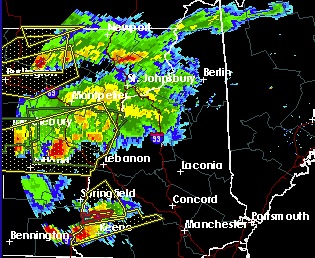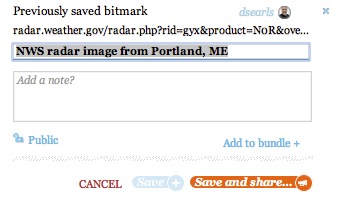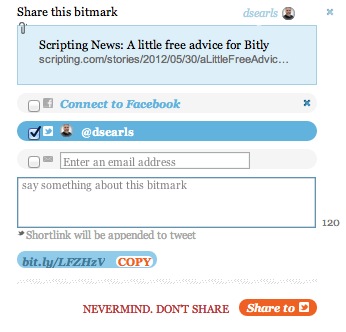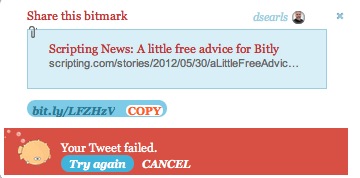[This post was read by Bitly folks, who reached out appreciatively. The thread continues with a follow-up post here.]
Last night huge thunderstorms moved across New Hampshire, and later across Boston.  There was even a tornado watch (the red outline north of Keene, in the radar image on the left, from the NOAA.) So I thought I’d tweet that.
There was even a tornado watch (the red outline north of Keene, in the radar image on the left, from the NOAA.) So I thought I’d tweet that.
It has been my practice for quite a while, when tweeting, to use the Bit.ly extension in my Chrome browser.
But then came a surprise. The little Bitly image had changed, and the pop-down word balloon, rather than giving me the shortlink I had expected, told me that Bit.ly was improving. I thought, “Oooh, shit.” Because there was nothing wrong with the old Bit.ly. It was simple and straightforward. You could either copy the shortlink from a window, or know it was on your clipboard after you clicked on the “copy” button, and it said “copied.”
The new and improved Bitly looks like this:

WTF? Ya gotta work to get this many things wrong. My personal list, from the top:
- I don’t know what a bitmark is and I don’t want to know. I want a shortlink.
- My Twitter handle is there, with my face. Why?
- Does the blue “x” close the whole thing or just my twitter handle?
- Why is it telling me the URL I want shortened? I see that one already. I want the short bit.ly URL.
- Why is it telling me the title of the page? I know that too.
- Why would I add a note? And to what? Is this a kind of Delicious move? I hardly ever used Delicious because it was too complicated. Now this is too.
- Why “Public?”
- What’s the “bundle” I would add this to?
- “CANCEL” what? Is something already in progress I don’t know about? (In this brief but intense Age of Facebook, when sites and services — e.g. Facebook Connect — silently provide means for advertisers and third parties to follow your scent like a cloud of flies, that’s a good bet.)
- What is Save+ for? To what? Why?
- What is “Save and share…” and what’s the difference between that and save? Why would I want a shortlink if not to share it on something that requires it, like Twitter?
- What are the symbols next to “Public” and “Save and share…”?
- And if, as I suspect, the only way I can get to the shortlink is to hit “Save and share…”, why make me go through that extra click — or, for that matter, ford the raging river of kruft above it to get there?
That was as far as I got before I had to go out to an event in the evening; and when I came back the storm (or something) had knocked my ISP’s Net connection off. So this morning, naturally (given all the above), there’s a tsunami of un-likes at https://twitter.com/#!/search/bitly, as well as out in the long-form blogosphere.
In URL Shortener Bitly Announces Big Update (Unfortunately, It Sucks, And Everybody Hates It), Shea Bennett of All Twitter at MediaBistro writes,
Yesterday, URL shortener of choice Bitly, which has generated more than 25 billion shortened links since inception, announced a change to their platform. A big change. New Bitly, they’re calling it.
Great. There’s only one small problem: everybody, and I mean everybody*, hates it.
Why? Because it’s taken what was a really useful and fast service into something that is bloated with unnecessary add-ons and buzzword crap, and made a one-click share into something that now takes at least three clicks, and is really, really confusing.
In the good old days, which we’ll refer to from now on as BNB (Before New Bitly), shortening links on Bitly was a breeze. A pleasure. It was fast, responsive and if you used an extension you could crunch down the URL of any webpage in a matter of seconds. If you had a Bitly account, you could then share that shortened link straight to Twitter via Bitly using the title of your choice.
So simple. So effective. So perfect.
And so gone.
The Bitly announcement is long: too long for a URL-shortening company. But this excerpt compresses the meat of it:
So what’s new? Now you can…
- Easily save, share and discover links — they’re called bitmarks, like bookmarks.
- Instantly search your saved bitmarks.
- Curate groups of bitmarks into bundles and collaborate on bundles with friends.
- Make any bitmark or bundle private or public.
- See what friends are sharing across multiple social networks, all in one place.
- Save and share links from anywhere with our new bitmarklet, Chrome extension and iPhone app.
It doesn’t stop here. We have big plans for bitly, and we want to build this neighborhood with our community. So get in there, start bitmarking and please tell us what you think!
So they want to be Delicious. And they want to play the social game. Or, as Samantha Murphy in Mashable puts it,
Bit.ly — which has more than 25 billion links saved since 2008 and gets about 300 million link-clicks each day — launched a redesign to not only expand its presence but give users more curation power. Among the most notable of the new tools is a profile page and what the company is calling “bitmarks,” which are similar to bookmarks.
I just checked Dave Winer, who, as I expected, weighs in with some words from the wise:
Based on what I see in their new product release it looks like they’re taking a step toward competing with Twitter. But they didn’t do it in an easy to use way. And the new product is not well user-tested. It looks like they barely used it themselves before turning it on for all the users. Oy. Not a good way to pivot.
Here’s some free advice, what I would do if I were them.
- Immediately restore the old interface, exactly as it was before the transition.
- Concurrently, issue a roadmap that goes as follows, so everyone knows where this thing is going.
- Take a few weeks to incorporate the huge amount of feedback they’ve gotten and streamline the new UI.
- Instead of launching it at bitly.com, launch it at newbetaworksserver.com…
The list goes on, and it’s exactly what they should do. At the very least, they should take Step #1. It’s the only way to restore faith with users.
Meanwhile, three additional points.
First is that URL shortening has always been a fail in respect to DNS — the Domain Name System, which was invented for ARPANET in 1982, and has matured as into hardened infrastructure over the decades since. (It’s essentially NEA: Nobody owns it, Everybody can use it, and Anybody can improve it.) On the other hand, URL shortening, as we know it so far, puts resolving the shortened URL in private hands, and those hands can (and will) change. That’s exactly what we’re seeing here with Bitly, and what we tend to see with all private infrastructures that serves public purposes.
Second is that Bitly, like Facebook, Twitter, Google and other advertising-supported businesses with millions (or billions) of users that pay nothing to those companies for the services performed, has a problem that has been familiar to commercial broadcasting since it was born in the 1920s: its consumers and its customers are different populations, and they are financially accountable only to the customers. Not to the consumers. In Bitly’s case its customers, so far, are enterprises that pay to have customized, or branded, short URLs. Could they make their consumers into customers as well, with a freemium model? Possible. I’d recommend it, because it would make the company financially accountable to those users.
Third is that people want their own curation power. The Cloud is a good and necessary form of utility infrastructure. But it’s a vulnerable place to have one’s own digital goods. True, everything, even the physical world, is ephemeral in the long run. But digital ephemera can be wiped out in an instant. We should have at least some sense of control over “what’s mine.” Bitly shortlinks are not really “mine” to begin with. As Yahoo showed with Delicious, commercially curated links are especially vulnerable. And, after this last move, Bitly has given us no new reason to trust them. And many new reasons not to.
So, will I use the new Bitly? Let’s look at what comes up when I hit the “Save and share…” button for Dave’s piece:

This is no less f’d than the other one. Let’s run it down.
- Okay, I’ve done the Delicious thing, I guess, if this is saved somewhere. Curation achieved, maybe. Guess I have to go Bitly.com to see. I’ll do that later.
- At first I thought the saved link (or whatever) might be under my @ handle on the upper right, but that just brings up a “sign out” option.
- I have no intention of connecting to Facebook.
- When I click on the blue bar with the checkmark in it, changes happen in the window, but I’m not sure what they are, other than getting un-checked.
- I have no intention of emailing it to anybody in this case. And actually, when I email a link, I tend to avoid shortlinks, because they obscure the source. And I’m also not dealing with a 140-character space limit. (Hmm… while we’re on short spaces subject, why not offer texting through SMS?)
- Did something get tweeted when I hit the blue bar? I dunno. Checked with Twitter. Nothing there, so guess not.
- I see “Shortlink will be appended to tweet,” but does that mean I tweet something if I put it in the box? Guess so, but not sure.
- I see the “Copy” next to the almost-illegible shortlink in the blue button. Okay, guess that’s what I should use. But I don’t yet because I want to understand the whole thing first.
- What does “NEVERMIND. DON’T SHARE” mean, except as a rebuke? Translated from the passive-aggressive, it says, “You don’t want to play this game? Okay, then fuck off.”
- The symbol in the orange “Share to” is barely recognizable as Twitter’s. I think. Not sure. I just clicked on it, and something came up briefly then went away.
When I clicked on it again, I got this:

I don’t want to try again, because I’m not sure it failed. So I check Twitter, and see this:

Damn! I didn’t want that!
This tweet has no context other than me and Bitly. Worse, it looks like a spam. Or like I’d been phished or hijacked in some way. At no time in the history of my blogging or tweeting have I ever uttered a single URL, let alone a shortened one. Or, if I did, I’m sure the context was clear.
This isn’t even a “copy.” It should say “tweet,” if it were to have any meaning at all. I guess I should have written something in the box above. But would that have worked? I dunno.
So I just went through the routine again, this time hitting the blue button that says COPY in orange. I did that for Dave’s post, and this one after I published it, and the result is this normal-form tweet: https://twitter.com/dsearls/status/207856808012951553
It is also now clear to me that the box is for writing a tweet to which the shortlink will be appended. But usually I don’t like to append links, but to work them into the text of the tweet.
Bottom lines:
- As Rebecca Greenfield says in The Atlantic Wire, Bit.ly Isn’t Really a Link Shortener Any More. Too bad.
- It still works, but the new routine now takes three clicks rather than two, and is far more complicated. The curation does work,, for now. When I go to Bitly.com, below “Welcome to the new bitly,” I see “1–10 OF 900 BITMARKS.” I can also search them. That’s cool. But I’d rather have something in my own personal cloud. And I’d pay Bitly, or anybody who values my independence, for helping me build that.
Mark these words: The next trend is toward independence for individuals, whether they be users or customers. Yet another new dependency is not what anybody wants. Dependencies like Bitly’s new one are a problem, not a solution. Bitly, Facebook, Google and Twitter making their APIs work together does not solve the dependency problem, any more than federations among plantations makes slaves free.
The end-to-end nature of the Net promised independence in the first place. When client-server became calf-cow in 1995, we sold out that promise, and we’ve been selling it out, more and more, ever since.
Now we need to take it back. Hats off to Bitly for making that abundantly clear.
Leave a Reply